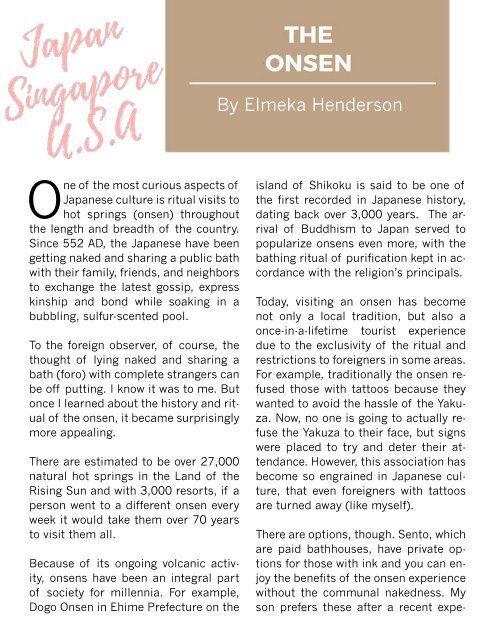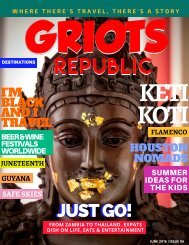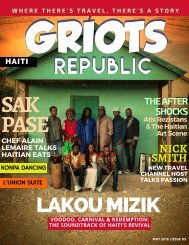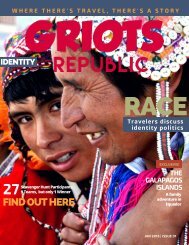GRIOTS REPUBLIC - AN URBAN BLACK TRAVEL MAG - DECEMBER 2016
2016 is coming to an end and in this issue of Griots Republic Barrington Irving and Calvin Ramsey join us to talk about the Legacy of Black Travel. We also have stories on Moore Town's Freedom Fighter, Global Bath House Culture, Christmas Markets in Cologne, and the Cocktail scene in Shanghai. Do not miss our "REAL" articles on "Runcations" and traveling to Antartica!
2016 is coming to an end and in this issue of Griots Republic Barrington Irving and Calvin Ramsey join us to talk about the Legacy of Black Travel. We also have stories on Moore Town's Freedom Fighter, Global Bath House Culture, Christmas Markets in Cologne, and the Cocktail scene in Shanghai. Do not miss our "REAL" articles on "Runcations" and traveling to Antartica!
Create successful ePaper yourself
Turn your PDF publications into a flip-book with our unique Google optimized e-Paper software.
By Elmeka Henderson<br />
One of the most curious aspects of<br />
Japanese culture is ritual visits to<br />
hot springs (onsen) throughout<br />
the length and breadth of the country.<br />
Since 552 AD, the Japanese have been<br />
getting naked and sharing a public bath<br />
with their family, friends, and neighbors<br />
to exchange the latest gossip, express<br />
kinship and bond while soaking in a<br />
bubbling, sulfur-scented pool.<br />
To the foreign observer, of course, the<br />
thought of lying naked and sharing a<br />
bath (foro) with complete strangers can<br />
be off putting. I know it was to me. But<br />
once I learned about the history and ritual<br />
of the onsen, it became surprisingly<br />
more appealing.<br />
There are estimated to be over 27,000<br />
natural hot springs in the Land of the<br />
Rising Sun and with 3,000 resorts, if a<br />
person went to a different onsen every<br />
week it would take them over 70 years<br />
to visit them all.<br />
Because of its ongoing volcanic activity,<br />
onsens have been an integral part<br />
of society for millennia. For example,<br />
Dogo Onsen in Ehime Prefecture on the<br />
island of Shikoku is said to be one of<br />
the first recorded in Japanese history,<br />
dating back over 3,000 years. The arrival<br />
of Buddhism to Japan served to<br />
popularize onsens even more, with the<br />
bathing ritual of purification kept in accordance<br />
with the religion’s principals.<br />
Today, visiting an onsen has become<br />
not only a local tradition, but also a<br />
once-in-a-lifetime tourist experience<br />
due to the exclusivity of the ritual and<br />
restrictions to foreigners in some areas.<br />
For example, traditionally the onsen refused<br />
those with tattoos because they<br />
wanted to avoid the hassle of the Yakuza.<br />
Now, no one is going to actually refuse<br />
the Yakuza to their face, but signs<br />
were placed to try and deter their attendance.<br />
However, this association has<br />
become so engrained in Japanese culture,<br />
that even foreigners with tattoos<br />
are turned away (like myself).<br />
There are options, though. Sento, which<br />
are paid bathhouses, have private options<br />
for those with ink and you can enjoy<br />
the benefits of the onsen experience<br />
without the communal nakedness. My<br />
son prefers these after a recent expe-














